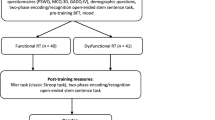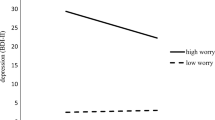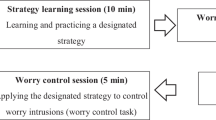“The greatest weapon against stress is our ability to choose one thought over another.” —William James.
Abstract
The current study examined a novel computerized cognitive reappraisal paradigm (REAP) for worry management in college-aged adults with a range of PSWQ scores (n = 98). Participants listed three current worries and were randomized to either REAP or a worry condition. For the REAP condition, participants selected positive reappraisal statements of their worries over negative ones. Before and after completing the reappraisal or worry task, participants discussed each worry. Participants rated their worries on coping ability, distress, and probability the worry would materialize. Relative to worry, the REAP group rated an increase in ability to cope with their worries whereas the results failed to provide evidence for a similar increase among the worry group. If similar findings emerge in clinical populations, REAP may eventually serve as a useful tool in augmenting cognitive behavioral therapy protocols.



Similar content being viewed by others
References
Aldao, A., & Mennin, D. S. (2012). Paradoxical cardiovascular effects of implementing adaptive emotion regulation strategies in generalized anxiety disorder. Behaviour Research and Therapy,50(2), 122–130.
Aldao, A., Nolen-Hoeksema, S., & Schweizer, S. (2010). Emotion-regulation strategies across psychopathology: A meta-analytic review. Clinical Psychology Review,30(2), 217–237.
American Psychiatric Association. (2013). DSM 5. Arlington: American Psychiatric Association.
Attali, Y. (2011). Immediate feedback and opportunity to revise answers: Application of a graded response IRT model. Applied Psychological Measurement,35(6), 472–479.
Attali, Y., & Powers, D. (2010). Immediate feedback and opportunity to revise answers to open-ended questions. Educational and Psychological Measurement,70(1), 22–35.
Ayduk, O., & Kross, E. (2009). Asking ‘why’ from a distance facilitates emotional processing: A reanalysis of Wimalaweera and Moulds (2008). Behaviour Research and Therapy,47(1), 88–92.
Ball, S. (1995). Anxiety and test performance. In C. D. Spielberger & P. R. Vagg (Eds.), Series in Clinical and Community Psychology. Test Anxiety: Theory, Assessment, and Treatment (pp. 107-113). Philadelphia, PA: Taylor & Francis.
Beck, A. T., & Dozois, D. J. (2011). Cognitive therapy: Current status and future directions. Annual Review of Medicine,62, 397–409.
Behar, E., Alcaine, O., Zuellig, A. R., & Borkovec, T. D. (2003). Screening for generalized anxiety disorder using the Penn State Worry Questionnaire: A receiver operating characteristic analysis. Journal of Behavior Therapy and Experimental Psychiatry,34(1), 25–43.
Berenbaum, H., Thompson, R. J., & Bredemeier, K. (2007). Perceived threat: Exploring its association with worry and its hypothesized antecedents. Behaviour Research and Therapy,45(10), 2473–2482.
Blechert, J., Wilhelm, F. H., Williams, H., Braams, B. R., Jou, J., & Gross, J. J. (2015). Reappraisal facilitates extinction in healthy and socially anxious individuals. Journal of Behavior Therapy and Experimental Psychiatry,46, 141–150.
Borkovec, T. D., Robinson, E., Pruzinsky, T., & DePree, J. A. (1983). Preliminary exploration of worry: Some characteristics and processes. Behaviour Research and Therapy,21(1), 9–16.
Borkovec, T. D., & Whisman, M. A. (1996). Psychosocial treatment for generalized anxiety disorder. In M. R. Mavissakalian & R. F. Prien (Eds.), Longterm treatments of anxiety disorders (pp. 171–199). Arlington, VA: American Psychiatric Association.
Brewin, C. R. (2006). Understanding cognitive behaviour therapy: A retrieval competition account. Behaviour Research and Therapy,44(6), 765–784.
Brown, T. A., Antony, M. M., & Barlow, D. H. (1992). Psychometric properties of the Penn State Worry Questionnaire in a clinical anxiety disorders sample. Behaviour Research and Therapy,30(1), 33–37.
Burns, D. D., & Spangler, D. L. (2000). Does psychotherapy homework lead to improvements in depression in cognitive–behavioral therapy or does improvement lead to increased homework compliance? Journal of Consulting and Clinical Psychology,68(1), 46.
Cristea, I. A., Kok, R. N., & Cuijpers, P. (2015). Efficacy of cognitive bias modification interventions in anxiety and depression: Meta-analysis. The British Journal of Psychiatry,206(1), 7–16.
Dugas, M. J., Letarte, H., Rhéaume, J., Freeston, M. H., & Ladouceur, R. (1995). Worry and problem solving: Evidence of a specific relationship. Cognitive Therapy and Research,19(1), 109–120.
Ehring, T., Tuschen-Caffier, B., Schnülle, J., Fischer, S., & Gross, J. J. (2010). Emotion regulation and vulnerability to depression: Spontaneous versus instructed use of emotion suppression and reappraisal. Emotion,10(4), 563.
Faul, F., Erdfelder, E., Lang, A.-G., & Buchner, A. (2007). G*Power 3: A flexible statistical power analysis program for the social, behavioral, and biomedical sciences. Behavior Research Methods,39, 175–191.
Goldin, P. R., Ziv, M., Jazaieri, H., Werner, K., Kraemer, H., Heimberg, R. G., et al. (2012). Cognitive reappraisal self-efficacy mediates the effects of individual cognitive-behavioral therapy for social anxiety disorder. Journal of Consulting and Clinical Psychology,80(6), 1034.
Gross, J. J. (1998). The emerging field of emotion regulation: An integrative review. Review of General Psychology,2(3), 271.
Gross, J. J., & John, O. P. (2003). Individual differences in two emotion regulation processes: Implications for affect, relationships, and well-being. Journal of Personality and Social Psychology,85(2), 348.
Gruber, J., Hay, A. C., & Gross, J. J. (2014). Rethinking emotion: Cognitive reappraisal is an effective positive and negative emotion regulation strategy in bipolar disorder. Emotion,14(2), 388.
Hirsch, C. R., & Mathews, A. (2012). A cognitive model of pathological worry. Behaviour Research and Therapy,50(10), 636–646.
Jamieson, J. P., Nock, M. K., & Mendes, W. B. (2012). Mind over matter: Reappraising arousal improves cardiovascular and cognitive responses to stress. Journal of Experimental Psychology: General,141(3), 417.
Jarvis, B. G. (2012). DirectRT (Version 2012) [Computer Software]. New York, NY: Empirisoft Corporation.
Kazantzis, N., Whittington, C., & Dattilio, F. (2010). Meta-analysis of homework effects in cognitive and behavioral therapy: A replication and extension. Clinical Psychology: Science and Practice,17(2), 144–156.
LeBreton, J. M., & Senter, J. L. (2008). Answers to 20 questions about interrater reliability and interrater agreement. Organizational Research Methods,11(4), 815–852.
Lewis, A. R., Zinbarg, R. E., & Durbin, C. E. (2010). Advances, problems, and challenges in the study of emotion regulation: A commentary. Journal of Psychopathology and Behavioral Assessment,32(1), 83–91.
MacLeod, C., & Mathews, A. (2012). Cognitive bias modification approaches to anxiety. Annual Review of Clinical Psychology,8, 189–217.
Mausbach, B. T., Moore, R., Roesch, S., Cardenas, V., & Patterson, T. L. (2010). The relationship between homework compliance and therapy outcomes: An updated meta-analysis. Cognitive Therapy and Research,34(5), 429–438.
McLaughlin, K. A., Borkovec, T. D., & Sibrava, N. J. (2007). The effects of worry and rumination on affect states and cognitive activity. Behavior Therapy,38(1), 23–38.
McRae, K., Ciesielski, B., & Gross, J. J. (2012a). Unpacking cognitive reappraisal: Goals, tactics, and outcomes. Emotion,12(2), 250.
McRae, K., Jacobs, S. E., Ray, R. D., John, O. P., & Gross, J. J. (2012b). Individual differences in reappraisal ability: Links to reappraisal frequency, well-being, and cognitive control. Journal of Research in Personality,46(1), 2–7.
Meyer, T. J., Miller, M. L., Metzger, R. L., & Borkovec, T. D. (1990). Development and validation of the Penn state worry questionnaire. Behaviour Research and Therapy,28(6), 487–495.
Molina, S., & Borkovec, T. D. (1994). The Penn State Worry Questionnaire: Psychometric properties and associated characteristics. In G. C. L. Davey & F. Tallis (Eds.), Wiley series in clinical psychology. Worrying: Perspectives on theory, assessment and treatment (pp. 265–283). Oxford: Wiley.
Murty, V. P., Ritchey, M., Adcock, R. A., & LaBar, K. S. (2010). fMRI studies of successful emotional memory encoding: A quantitative meta-analysis. Neuropsychologia,48(12), 3459–3469.
Orne, M. T. (1962). On the social psychology of the psychological experiment: With particular reference to demand characteristics and their implications. American Psychologist,17(11), 776.
Pratto, F., & John, O. P. (1991). Automatic vigilance: The attention-grabbing power of negative social information. Journal of Personality and Social Psychology,61(3), 380–391.
Ray, R. D., McRae, K., Ochsner, K. N., & Gross, J. J. (2010). Cognitive reappraisal of negative affect: Converging evidence from EMG and self-report. Emotion,10(4), 587.
Rees, C. S., McEvoy, P., & Nathan, P. R. (2005). Relationship between homework completion and outcome in cognitive behaviour therapy. Cognitive Behaviour Therapy,34(4), 242–247.
Resick, P. A., Monson, C. M., & Chard, K. M. (2006). Cognitive processing therapy: Veteran/military version. Clinical Psychology,74, 898–907.
Ruscio, A. M., Seitchik, A. E., Gentes, E. L., Jones, J. D., & Hallion, L. S. (2011). Perseverative thought: A robust predictor of response to emotional challenge in generalized anxiety disorder and major depressive disorder. Behaviour Research and Therapy,49(12), 867–874.
Stöber, J. (1998). Reliability and validity of two widely-used worry questionnaires: Self-report and self-peer convergence. Personality and Individual Differences,24(6), 887–890.
Urry, H. L. (2009). Using reappraisal to regulate unpleasant emotional episodes: Goals and timing matter. Emotion,9(6), 782.
Watkins, E. R. (2008). Constructive and unconstructive repetitive thought. Psychological Bulletin,134(2), 163.
Funding
This research was supported by Northwestern University’s Graduate Research Grant (GRG). Nehjla M. Mashal was supported by the VA Advanced Fellowship Program in Mental Health Research and Treatment, Office of Academic Affiliations; writing of this manuscript was supported in part by the Sierra Pacific MIRECC at the VA Palo Alto Health Care System.
Author information
Authors and Affiliations
Corresponding author
Ethics declarations
Conflict of Interest
Nehjla M. Mashal, Sherry A. Beaudreau, Michael A. Hernandez, Rachel Cackler Duller, Holly Romaniak, Ki Eun Shin, Ken A. Paller, and Richard E. Zinbarg declare that they have no conflict of interest.
Ethical Approval
All procedures performed involving human participants in this study were in accordance with the ethical standards of the institutional Review Board (IRB) at Northwestern University, Evanston Campus and with the 1964 Helsinki declaration and its later amendments or comparable ethical standards.
Animal Rights
This article does not contain any studies with animals performed by any of the authors.
Informed Consent
Informed consent was obtained from all individual participants included in the study.
Additional information
Publisher's Note
Springer Nature remains neutral with regard to jurisdictional claims in published maps and institutional affiliations.
Study findings have not been previously published or submitted for publication elsewhere, other than as part of a dissertation. The data that support the findings of this study are available from the corresponding author upon reasonable request. The views expressed in this article are those of the authors and not necessarily those of the Department of Veterans Affairs or the Federal Government.
Rights and permissions
About this article
Cite this article
Mashal, N.M., Beaudreau, S.A., Hernandez, M.A. et al. A Brief Worry Reappraisal Paradigm (REAP) Increases Coping with Worries. Cogn Ther Res 44, 216–228 (2020). https://doi.org/10.1007/s10608-019-10053-8
Published:
Issue Date:
DOI: https://doi.org/10.1007/s10608-019-10053-8




